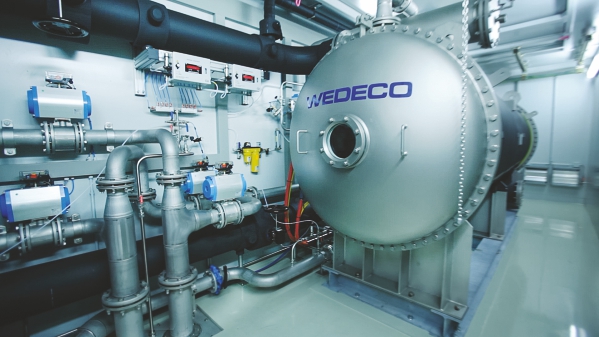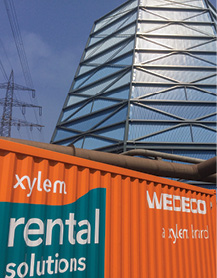Armed with a comprehensive range of chemical-free water treatment solutions, such as ozone, UV and other advanced filtration methods, Xylem Water Solutions India Private Limited is helping the Indian pulp and paper industry to effortlessly fulfill their water circularity aims. This was revealed by Mr. Alexis Metais, Pulp & Paper Key Account Manager, Xylem Water Solutions India Private Limited, during an exclusive interview with Paper Mart.

Paper Mart: How has your understanding or approach to water circularity evolved over time? How are you helping mills move closer to achieving it?
Alexis Metais: Xylem provides a comprehensive range of chemical-free water treatment solutions, including ozone, UV and filtration technologies, as well as specialized products for complex applications, from intelligent aeration systems to advanced filtration methods. A key driver behind the adoption of chemical-free solutions has always been the goal of enhancing water circularity, or at the very least, enabling the potential for it. Taking ozone as an example: it is well-known that ozone bleaching delivers excellent pulp quality, achieves high brightness levels with minimal reversion, reduces operating costs, and significantly lowers bleach plant effluent – both in volume and in chemical oxygen demand (COD) and color loads – compared to conventional Elemental Chlorine- Free (ECF) bleaching.
Improved circularity is another major advantage. In standard ECF bleaching, the filtrates contain chlorides, which are highly corrosive and cannot be recirculated, as they must not reach the recovery boiler in significant quantities. An alternative approach is to minimize or eliminate chlorine-based chemicals in the initial bleaching stage. Using ozone, either in a standalone Z-stage or in combination with a small dose of chlorine dioxide in a Z/D stage without intermediate washing, enables the redirection of the extraction stage filtrates to the post-oxygen washer. This is particularly beneficial for pulp mills aiming to reduce their effluent discharge.
Today, there is also growing demand for ozone and UV technologies in process and cooling water applications. Both solutions contribute to reduced freshwater intake, supporting more sustainable water management practices.
Watch: In Pursuit of Lesser Water Footprint
PM: Based on your experience, which current technologies are having the greatest real-world impact in improving water circularity in paper mills?
AM: When faced with a problem, there are generally two approaches. We can either try to solve it directly – for example, by treating water through filtration and reverse osmosis, or we try to eliminate the root cause of the problem.
Take water recirculation, for instance. It is sometimes not possible because the water contains corrosive compounds or has a high concentration of contaminants. I’ve already discussed ozone bleaching, so let’s now consider cooling water treatment. Cooling water typically circulates in a closed loop, absorbing heat from industrial processes and releasing it in a cooling tower. In the tower, the water comes into direct contact with air and cooling occurs through evaporation. However, this process also draws in dust and organic matter, creating ideal conditions for bacterial and algal growth. This biological activity leads to slime and scale formation, which reduces heat transfer efficiency and promotes corrosion.


To combat this, various chemicals are added to control microbial growth and prevent scaling. Traditional cooling tower water treatment involves the continuous addition of multiple chemicals. However, as water evaporates, the concentration of dissolved solids and treatment chemicals increases, limiting how many times the water can be circulated. The water must be partially discharged (blowdown) and replaced with fresh water (makeup water). Because of the biocidal content, this blowdown must be treated before being released into the environment.
Ozone offers a powerful alternative to conventional chemical treatments. As a strong oxidant and biocide, ozone can replace most of the chemicals typically used. It introduces no organic material into the system, eliminating the need for defoamers or dispersants. When operating at high cycles of concentration, corrosion inhibitors are often unnecessary, as the water becomes saturated with metal ions. Additionally, ozone-treated water naturally stabilizes at a pH of around 8 to 8.5, above the corrosion threshold, so no pH adjustment is needed.
Ozone also prevents scale formation by eliminating colony-forming bacteria, which are typically responsible for producing the biofilm that acts as a binding agent for scale. As a result, any metals that reach saturation levels precipitate as fine particles, which can be easily removed by sand filters. Thanks to the high quality of ozone-treated water, cooling systems can operate at much higher cycles of concentration, or even sometimes on a zero-blowdown basis, significantly reducing water consumption and environmental impact.
Also Read: Sidhu Engineering Works: Robo Cleaner Reduces 92% Water Consumption in Showering Process
PM: What are the key challenges your clients face in improving water management or achieving circularity?
AM: The main challenge lies in regulation. For many companies, regulatory pressure is the key trigger for action. Circularity is often only pursued when it becomes a requirement of environmental permits. However, the industry needs greater clarity and predictability regarding current and future regulations. It’s often difficult to determine where authorities intend to set the bar, which leads many stakeholders to adopt a wait-and-watch approach. This uncertainty can delay progress. The real challenge, then, is simply to begin. Once there is a clear commitment, whether driven by regulation or internal sustainability goals, solutions are readily available. And those who have already embarked on the path towards circularity take justifiable pride in their achievements.



